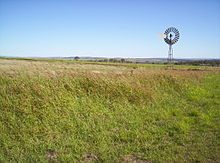The Darling Downs is an inland region in the south of Queensland. Just west of the south-east, the Darling Downs has the typical rural Queensland feel.
While much of it is farmland, parts of the region is in a world heritage area, under Gondwana Rainforests of Australia. It is also one of the most urbanised inland regions of Australia, containing Toowoomba, the largest inland city in Australia by natural growth (the largest is Canberra, but that was a planned city, and its population was not caused by natural growth).
Cities[edit]
- 1 Chinchilla
- 2 Goondiwindi
- 3 Inglewood
- 4 Killarney
- 5 Oakey
- 6 Roma
- 7 St George
- 8 Stanthorpe
- 9 Texas
- 10 Toowoomba - the main city in the region
Other destinations[edit]
- 1 Bunya Mountains National Park - find 10 kg Bunya pine cones in Queensland's second national park
Understand[edit]

A swathe of rolling plains and blue skies, the Darling Downs is a fertile pastoral and farming region in Queensland west of the Great Dividing Range.
Various vegetables, beans, cotton, wheat, barley and sorghum are grown on the hill country of the Darling Downs. Long roads, bushes, meandering rivers and herds of cattle stretch between the farmland and characterise the region. Other typical landscapes in the region include irrigation systems, windmills driving pumps and water from the Great Artesian Basin, light aircraft spraying fields, old sheep shearers' huts and other scattered relics of a bygone era from the early days of European settlement.
Get in[edit]
The most used airport in the Darling Downs region by far is 1 Toowoomba Wellcamp Airport (formerly Brisbane West Wellcamp Airport; WTB IATA) (is located 17km west of Toowoomba). and despite its former name, the airport is 130 km from Brisbane and is not a practical alternative to Brisbane Airport (BNE IATA) hence why this airport is even a practical airport unlike Newcastle airport..
When coming via car, the most used way from coming from the capital of Brisbane is via the A2 Warrego Highway which is basically a divided highway up until Charlton in West Toowoomba, but when coming from the New England region of New South Wales, it's the New England Highway.
Get around[edit]
There is limited private operators in the Darling Downs region and as such the primary way of getting around the region is via car. Rental cars can be found in the larger cities, but many choose to rent a car in Brisbane where there is a larger range of vehicles available and then do the drive.
See and do[edit]
Darling Downs has many natural and heritage attractions including:
- Cunnighams Gap
- Spicers Gap
- Darling Downs Zoo
- Queen Mary Falls
The region is popular with tourists because of its many natural and heritage attractions, including the Goomburra State Forest, and many sites in Main Range National Park. Lake Broadwater is the only natural lake on the tablelands.
Rather unusually, the town of Jandowae gained fame after offering vacant blocks of land for just a simple $1. It was done to encourage more people to settle in the small town which had less than 1,000 people (2001).
The Cobb & Co Museum has displays of horse-drawn vehicles and material on the history of the Darling Downs. The Jondaryan Woolshed is a heritage-listed shearing shed situated at a site where a tourist operator has collected numerous related structures. The region has also a small zoo, Darling Downs Zoo near Clifton.
Elsewhere, in towns like Texas, which is quite a small town in the Darling Downs. But for those that are interested about the railway (railroad) history of Texas, Texas Railway Museum is a small but worth a look place. There's also the Texas Heritage Centre & Tobacco Museum[dead link] more onto Texas' heritage.
National parks[edit]
- See also: Queensland national parks
The primary national park in this region is the Main Range National Park, which is a world heritage park under Gondwana Rainforests of Australia, though it is certainly not the only one. The Bunya Mountains National Park is another popular park home of the bunya pine, and was established in 1908, making it the second Queensland national park. If you're looking to salvage the best mountain scenery the region has to offer, two particularly popular parks with locals which are within an hours reach from Toowoomba is Crows Nest National Park, home to some diamond looking valleys and spectacular rock pools and waterfalls, and Ravenswood National Park, which may not be an overly large park, but many come to its lookout for some of mountainous rural inland Queensland.
Eat[edit]
When it comes to where you can eat, it significantly varies by place and this region isn't particularly known for its food despite it being home to Australia's largest concentration of feedlots, and hence why there's no specific well known local specialty. Some places such as Kingaroy is specialised in peanuts, while others such as Goondiwindi aren't known for any particular type of food.
Drink[edit]
In the Southern Downs region surrounding Stanthorpe is in an area called the Granite Belt there are now over sixty cellar doors, wineries, and vineyards. The industry first began as a table grape growing region that by the mid-1960s was starting to plant wine grape cultivars. The Darling Downs has a subtropical highland climate atypical to the rest of Queensland owing due to its elevation as the altitudes range from 680 to over 1200 m above sea level ideally suiting to premium wine production.
Stay safe[edit]
Go next[edit]

